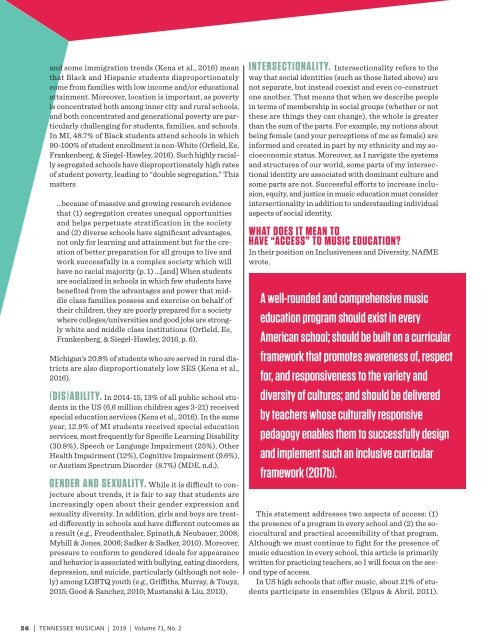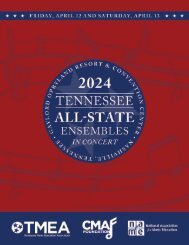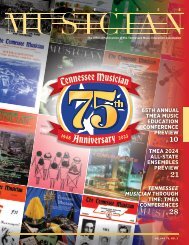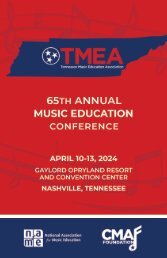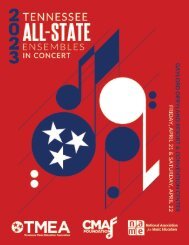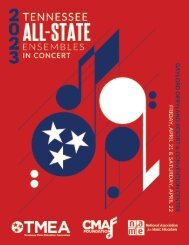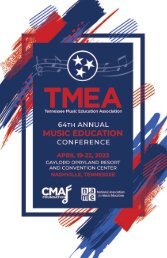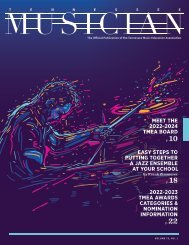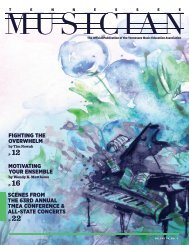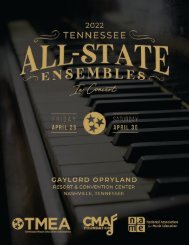TN Musician Vol. 71 No. 2
Create successful ePaper yourself
Turn your PDF publications into a flip-book with our unique Google optimized e-Paper software.
and some immigration trends (Kena et al., 2016) mean<br />
that Black and Hispanic students disproportionately<br />
come from families with low income and/or educational<br />
attainment. Moreover, location is important, as poverty<br />
is concentrated both among inner city and rural schools,<br />
and both concentrated and generational poverty are particularly<br />
challenging for students, families, and schools.<br />
In MI, 48.7% of Black students attend schools in which<br />
90-100% of student enrollment is non-White (Orfield, Ee,<br />
Frankenberg, & Siegel-Hawley, 2016). Such highly racially<br />
segregated schools have disproportionately high rates<br />
of student poverty, leading to “double segregation.” This<br />
matters<br />
…because of massive and growing research evidence<br />
that (1) segregation creates unequal opportunities<br />
and helps perpetuate stratification in the society<br />
and (2) diverse schools have significant advantages,<br />
not only for learning and attainment but for the creation<br />
of better preparation for all groups to live and<br />
work successfully in a complex society which will<br />
have no racial majority (p. 1) …[and] When students<br />
are socialized in schools in which few students have<br />
benefited from the advantages and power that middle<br />
class families possess and exercise on behalf of<br />
their children, they are poorly prepared for a society<br />
where colleges/universities and good jobs are strongly<br />
white and middle class institutions (Orfield, Ee,<br />
Frankenberg, & Siegel-Hawley, 2016, p. 6).<br />
Michigan’s 20.8% of students who are served in rural districts<br />
are also disproportionately low SES (Kena et al.,<br />
2016).<br />
(DIS)ABILITY. In 2014-15, 13% of all public school students<br />
in the US (6.6 million children ages 3-21) received<br />
special education services (Kena et al., 2016). In the same<br />
year, 12.9% of MI students received special education<br />
services, most frequently for Specific Learning Disability<br />
(30.8%), Speech or Language Impairment (25%), Other<br />
Health Impairment (12%), Cognitive Impairment (9.6%),<br />
or Austism Spectrum Disorder (8.7%) (MDE, n.d.).<br />
GENDER AND SEXUALITY. While it is difficult to conjecture<br />
about trends, it is fair to say that students are<br />
increasingly open about their gender expression and<br />
sexuality diversity. In addition, girls and boys are treated<br />
differently in schools and have different outcomes as<br />
a result (e.g., Freudenthaler, Spinath,& Neubauer, 2008;<br />
Myhill & Jones, 2006; Sadker & Sadker, 2010). Moreover,<br />
pressure to conform to gendered ideals for appearance<br />
and behavior is associated with bullying, eating disorders,<br />
depression, and suicide, particularly (although not solely)<br />
among LGBTQ youth (e.g., Griffiths, Murray, & Touyz,<br />
2015; Good & Sanchez, 2010; Mustanski & Liu, 2013).<br />
INTERSECTIONALITY. Intersectionality refers to the<br />
way that social identities (such as those listed above) are<br />
not separate, but instead coexist and even co-construct<br />
one another. That means that when we describe people<br />
in terms of membership in social groups (whether or not<br />
these are things they can change), the whole is greater<br />
than the sum of the parts. For example, my notions about<br />
being female (and your perceptions of me as female) are<br />
informed and created in part by my ethnicity and my socioeconomic<br />
status. Moreover, as I navigate the systems<br />
and structures of our world, some parts of my intersectional<br />
identity are associated with dominant culture and<br />
some parts are not. Successful efforts to increase inclusion,<br />
equity, and justice in music education must consider<br />
intersectionality in addition to understanding individual<br />
aspects of social identity.<br />
WHAT DOES IT MEAN TO<br />
HAVE “ACCESS” TO MUSIC EDUCATION?<br />
In their position on Inclusiveness and Diversity, NAfME<br />
wrote,<br />
A well-rounded and comprehensive music<br />
education program should exist in every<br />
American school; should be built on a curricular<br />
framework that promotes awareness of, respect<br />
for, and responsiveness to the variety and<br />
diversity of cultures; and should be delivered<br />
by teachers whose culturally responsive<br />
pedagogy enables them to successfully design<br />
and implement such an inclusive curricular<br />
framework (2017b).<br />
This statement addresses two aspects of access: (1)<br />
the presence of a program in every school and (2) the sociocultural<br />
and practical accessibility of that program.<br />
Although we must continue to fight for the presence of<br />
music education in every school, this article is primarily<br />
written for practicing teachers, so I will focus on the second<br />
type of access.<br />
In US high schools that offer music, about 21% of students<br />
participate in ensembles (Elpus & Abril, 2011).<br />
26 | TENNESSEE MUSICIAN | 2019 | <strong>Vol</strong>ume <strong>71</strong>, <strong>No</strong>. 2


